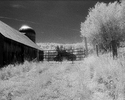Pentode
Member
I have been using the Kodak Rapid Fixer that comes in two part kits recently. I tend to only use the hardener (part B) when I'm using certain films, otherwise I just use part A (fixer). What that means is I use a lot more of part A than I'll ever use of part B, but every time I buy fixer it comes with another bottle of hardener.
So, here's my question: Will Kodak's hardener work with any ammonium thiosulfate rapid fixer? If it will than I could buy any rapid fixer (that doesn't come with a bottle of hardener) until I use up the hardener I have and only buy the Kodak when I need more hardener. For extra credit: If it will work, would it be used in the same dilution or would it depend upon the formulation of the other brand's fixer?
Thanks in advance if anyone knows this!
Forgive me if this has been addressed before. I did a search and came up empty.
So, here's my question: Will Kodak's hardener work with any ammonium thiosulfate rapid fixer? If it will than I could buy any rapid fixer (that doesn't come with a bottle of hardener) until I use up the hardener I have and only buy the Kodak when I need more hardener. For extra credit: If it will work, would it be used in the same dilution or would it depend upon the formulation of the other brand's fixer?
Thanks in advance if anyone knows this!
Forgive me if this has been addressed before. I did a search and came up empty.





 ) people used Kodak F5 or F6 fixer . It all was hardening fixer. Then in the 70's East Street Gallery invented the archival washer, thus sewing the fear of good old fixer into the hearts and minds of all.
) people used Kodak F5 or F6 fixer . It all was hardening fixer. Then in the 70's East Street Gallery invented the archival washer, thus sewing the fear of good old fixer into the hearts and minds of all.